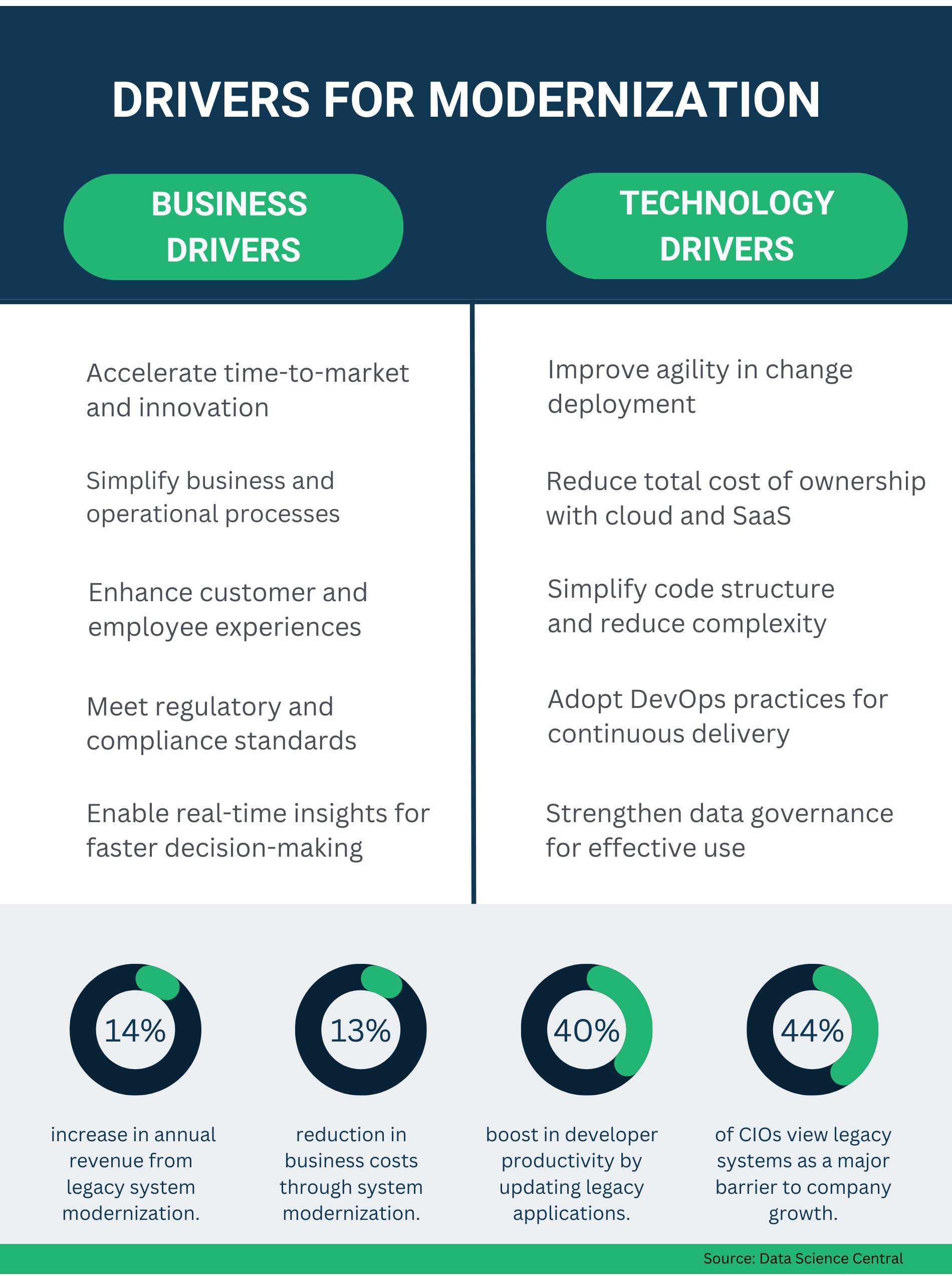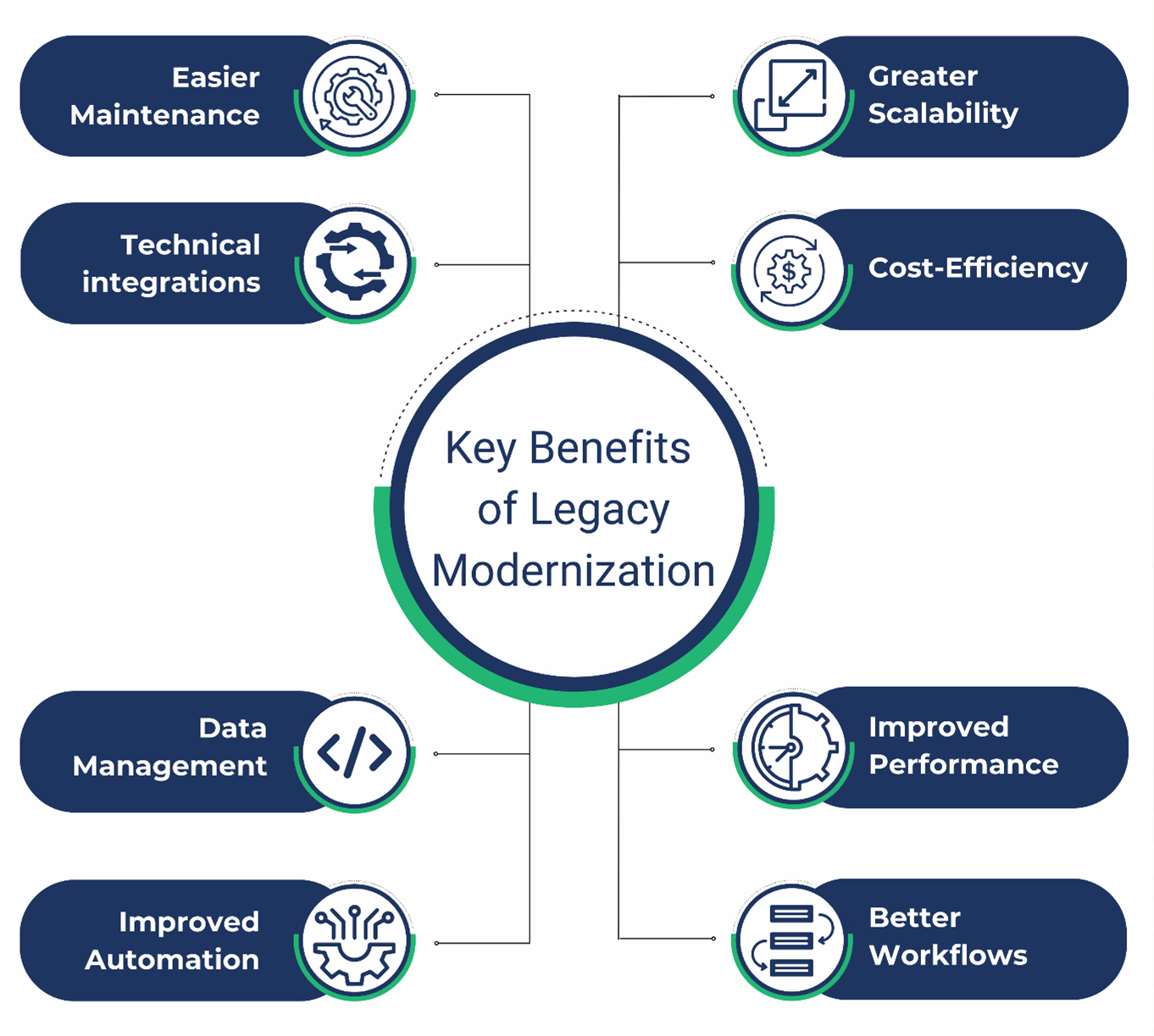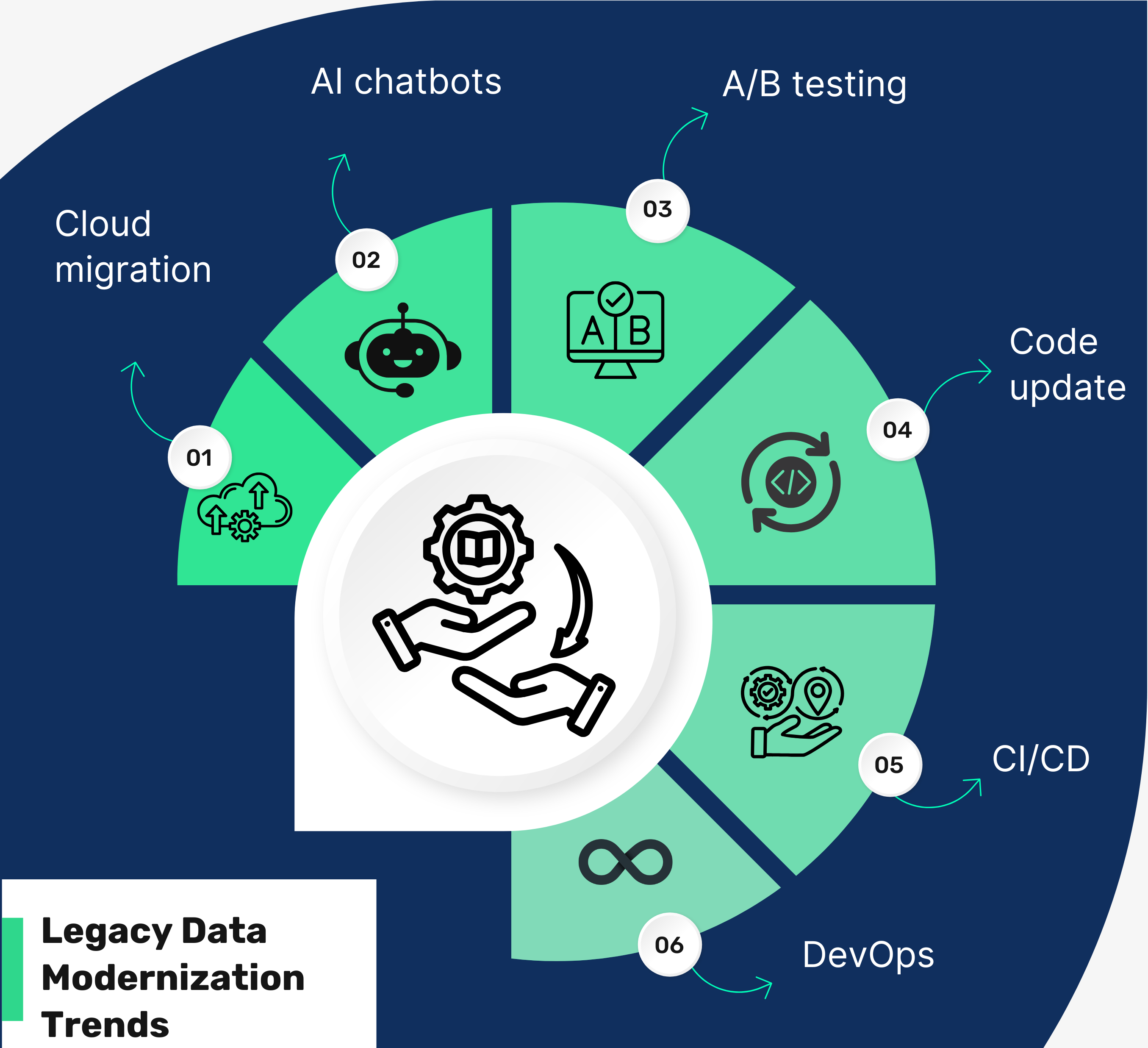
The pressure to innovate and stay agile has never been higher as businesses evolve in a fast-paced digital landscape. Companies that continue to rely on outdated legacy systems find themselves increasingly constrained, unable to meet the agility and scalability demands of modern business. Legacy systems, while once essential, are now bottlenecks—hindering efficiency, growth, and innovation.
For leaders, legacy systems present growing challenges like project delays, mismanaged resources, and rising costs, making modernization critical to maintaining a competitive edge. Holding onto legacy systems often results in mounting costs and missed opportunities for growth. This is why legacy modernization is no longer a technical upgrade—it is a strategic necessity for companies aiming to thrive in a fast-paced, digital-first environment.
However, transitioning from legacy systems requires more than simply replacing old technology with new. It demands a comprehensive transformation in how businesses manage their systems, projects, and decision-making processes. This is where predictive intelligence emerges as a game-changing tool—not just for modernization efforts, but also for ensuring ongoing operational success. In this article, we’ll explore eight key strategies for modernizing legacy systems and discuss how predictive project management tools can ensure these transformations succeed.

The Importance of Legacy Modernization
Legacy modernization refers to the process of transforming outdated systems into more efficient, secure, and scalable infrastructures. Most legacy systems were designed to meet the needs of a different business landscape—one that no longer exists. As the saying goes, "What got you here won’t get you there." As markets, customer expectations, and technology evolve, these systems become liabilities, making it harder for businesses to respond to new challenges and opportunities.
Failing to modernize means losing operational efficiency and competitive edge. Leaders today must make strategic decisions that align technology with business improvement goals, ensuring that their infrastructure is agile enough to meet future demands. The shift from legacy systems to modern, cloud-based, and AI-powered solutions is essential for maintaining security, reducing costs, and enabling scalability.
Here are some of the most pressing challenges companies face when relying on legacy systems:
- Inflexibility - Legacy systems are difficult to integrate with modern tools, limiting collaboration and responsiveness.
- High Maintenance Costs - A significant portion of IT budgets is spent just maintaining these systems, diverting resources from innovation.
- Security Risks - Older systems are more vulnerable to cyberattacks and lack modern encryption standards.
- Limited Scalability - As businesses grow, legacy systems struggle to scale, leading to performance issues and downtime.
For decision-makers, the need for modernization is clear, but the question remains - How do you execute this transformation efficiently while minimizing risk?

8 Essential Strategies for Legacy Modernization
- Rehosting (Lift-and-Shift) - This approach involves moving your legacy system to a new environment, such as the cloud, with minimal changes to the underlying code. It’s a fast and cost-effective way to gain immediate benefits like improved scalability without fully reengineering the system. However, rehosting doesn’t unlock the full potential of the cloud’s capabilities.
- Refactoring - Refactoring focuses on improving the system’s internal structure without altering its external behavior. This approach optimizes the existing code for better performance and maintainability, making it easier to adapt to future demands. It’s a strategic way to enhance efficiency while preserving the core functions of the system.
- Replatforming - Replatforming is a middle-ground approach where parts of the system are modernized to take better advantage of new platforms, such as moving to a cloud infrastructure. Unlike rehosting, it involves some level of code change, allowing businesses to benefit from enhanced performance while maintaining key legacy components.
- Rearchitecting - Rearchitecting is a more radical approach, involving a complete redesign of the system’s architecture. This method is ideal for businesses that want to integrate new technologies such as microservices or cloud-native applications. By rearchitecting, businesses can achieve greater flexibility, scalability, and agility, though this approach requires more time and resources.
- Replacing - In cases where the legacy system is too outdated to be salvaged, a full replacement may be necessary. While this is the costliest and time-intensive option, it offers the greatest opportunity for innovation, enabling businesses to rebuild their infrastructure using modern technologies designed for today’s needs.
- Encapsulation - Encapsulation allows businesses to integrate legacy systems with modern applications by using APIs to create a modern interface. This strategy is especially useful when businesses need to keep their legacy systems running but want to interact with modern platforms seamlessly.
- Microservices Architecture - One of the most effective modernization strategies is transitioning from a monolithic legacy system to a microservices architecture. This approach breaks down the system into smaller, independent services, making it easier to update, scale, and deploy without impacting the entire system. Microservices improve agility and reduce downtime, offering a modern approach to scaling.
- DevOps Integration - Integrating DevOps practices into legacy modernization efforts allows businesses to streamline their workflows, automate testing, and improve collaboration between development and operations teams. This approach accelerates the deployment of modernized systems while reducing risks.

Benefits of Legacy Modernization
Legacy modernization goes beyond technical upgrades—it transforms how businesses operate, enhancing efficiency and competitiveness. Here are the key benefits of adopting legacy modernization software:
- Cost Reduction - Modernization tools reduce the high costs of maintaining legacy systems by streamlining processes and minimizing manual interventions, cutting down on failures and downtime.
- Increased Reusability - Existing software components can be repurposed for new applications, reducing development time and lowering resource usage.
- Increased Agility - Modernized systems enable businesses to respond quickly to market shifts and customer demands, enhancing overall business agility.
- Increased Flexibility - Legacy modernization tools integrate with new platforms and technologies, allowing businesses to scale and adapt with ease.
- Improved Performance - Updated technology increases system speed, reduces latency, and enhances reliability, providing a better overall user experience.
- Increased Maintainability - Modernized systems are easier to maintain, reducing the time needed for updates and freeing IT teams to focus on strategic tasks.
- Increased Competitiveness - Modern systems allow businesses to meet industry standards, comply with regulations, and stay competitive in a fast-changing market.
- Increased Availability - Modern systems offer higher uptime and availability, ensuring consistent operations and better customer satisfaction.
- Faster Time-to-Market - Automating processes through modernization software speeds up development, enabling businesses to bring new products to market more quickly.
- Increased Interoperability - Modernized systems integrate more easily with other applications, enabling seamless business communication and collaboration between tools.

The Role of Predictive Intelligence in Legacy Modernization
While the benefits of legacy modernization are clear, ensuring that these modernization projects stay on track requires more than just technological upgrades. This is where predictive intelligence comes into play, providing businesses with real-time monitoring insights and foresight to ensure smooth transitions and proactive decision-making.
Predictive intelligence is vital for keeping modernization projects on track. With real-time insights and risk mitigation, AI-powered tools ensure proactive decision intelligence, enabling projects to stay aligned with goals.
Here’s how predictive intelligence ensures that modernization projects not only stay on track but deliver long-term success:
- Early Risk Detection - Predictive intelligence tools can analyze data in real time to identify potential risks before they escalate. This allows project leaders to address issues proactively, ensuring that modernization efforts are not derailed by unforeseen challenges.
- Feedback Integration - Modernization projects involve multiple stakeholders, each bringing their own perspectives and requirements. Predictive intelligence tools can continuously capture and analyze stakeholder feedback, ensuring that the next steps of the project are informed by real-time insights.
- Resource Optimization - One of the biggest challenges in modernization projects is resource allocation. Predictive intelligence helps project managers optimize resources—whether human, financial, or technical—by identifying the most critical areas that need attention.
- Risk Mitigation with Foresight - Predictive tools don’t just identify risks; they also provide foresight for mitigation strategies. This allows businesses to manage potential setbacks before they occur, ensuring that projects stay on track and are completed with minimal disruption.
By integrating predictive intelligence into legacy modernization efforts, businesses can ensure that they don’t just react to problems as they arise but anticipate and address challenges before, they impact the business or project. This shift from reactive to proactive leadership is crucial for maintaining momentum in large-scale transformations.
Best Practices for Legacy Modernization Success
To ensure that your legacy modernization efforts are successful, consider the following best practices:
- Start with a Thorough Assessment - Begin by evaluating the current state of your legacy systems. Identify pain points, inefficiencies, and the key areas where modernization can have the most significant business impact.
- Adopt a Phased Approach - Modernization doesn’t have to happen all at once. Breaking the project into phases reduces the risk of disruption and allows businesses to see incremental improvements.
- Invest in Change Management - Modernization isn’t just about technology—it’s about people. Ensure that your team is well-equipped to handle the transition by providing training and ongoing support.
- Prioritize Security and Compliance - Make security a core component of your modernization efforts. Modernized systems should incorporate the latest security protocols and adhere to regulatory requirements.
- Leverage Predictive Tools - As discussed, integrating predictive intelligence into your modernization projects ensures you’re always one step ahead. From risk mitigation to resource optimization, predictive tools are essential for long-term success.

The Risks of Failing to Modernize
While legacy systems may still work, their true cost is hidden in inefficiencies, maintenance, and missed opportunities. Businesses that delay modernization face significant risks:
- Operational Bottlenecks - Legacy systems slow down processes, making it difficult to respond to market demands in real-time.
- Missed Innovation - Sticking with outdated systems stifles innovation. Competitors that embrace modernization can introduce new products, features, or services faster and more efficiently.
- Security Vulnerabilities - Older systems lack the modern security measures needed to protect against today’s sophisticated cyber threats. This makes organizations more vulnerable to breaches, which can have devastating financial and reputational consequences.
Failing to modernize is not just about surviving today’s challenges but about being positioned for tomorrow’s opportunities. Legacy modernization ensures your business is prepared to compete in an increasingly digital and agile world.
Conclusion
Legacy modernization is no longer just an option—it’s a critical investment in an organization’s future. By adopting key strategies such as rehosting, refactoring, and integrating microservices, businesses can reduce costs, improve security, and scale with confidence. However, modernization efforts must be tightly aligned with business goals, with best practices like phased implementations and strong change management playing a vital role in ensuring long-term success.
But modernization is not just about technology—it’s about creating a future-proof environment where teams, technology, and operations can thrive. This is where leveraging robust predictive intelligence solution like TrueProject becomes indispensable. By integrating TrueProject’s KPI-based predictive SaaS solutions, into modernization projects, businesses can ensure that feedback is gathered, risks are identified early, and foresights are provided to mitigate potential issues before they escalate. TrueProject’s predictive intelligence ensures that legacy transition projects stay on track, with real-time insights and early warning signs offering proactive solutions that minimize disruptions. With predictive intelligence at the core, businesses can transition seamlessly, ensuring that they not only keep pace with technological change but also maximize growth and operational efficiency.
More information on TrueProject at trueprojectinsight.com






